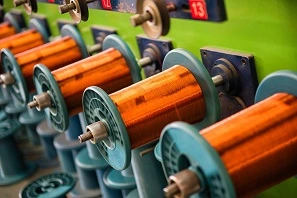Copper enameled wire serves as the primary raw material for wire winding in products like motors, electrical appliances, and household electronics.
The enameled copper winding wire consists of two main components: the conductor and the insulation layer. The conductor material typically comprises copper or aluminum alloy, while the insulation layer consists of various resin coatings.

Diving into Common Types of Copper Enameled Wire
QA Polyurethane Enameled Wire (UEW)
UEW insulated copper winding wire, also known as polyurethane enameled wire, is often designated for 130-class polyurethane enameled wire, indicated as UEW/130. For the 155 class, an 'M' is added, such as MUEW/155.
Composition: Copper conductor and polyurethane resin.
Features: Easily dyeable, solderable, low dielectric loss at high frequencies.
QA (Polyurethane): With good coloring and high-frequency performance, QA wires can be soldered directly without the need for stripping paint, enhancing work efficiency.
QA wires exhibit superior solderability, allowing for direct soldering without the need for paint removal. This greatly enhances flexibility during customer coil winding, saving costs and earning widespread acclaim.
QZ Polyester Enameled Wire (PEW)
PEW, denoted as polyester enameled wire, typically represents 130-class polyester enameled wire, labeled as PEW/130. For the 155 class, an 'M' is added, like MPEW/155.
Composition: Copper conductor and polyester resin.
Features: Good mechanical strength, excellent adhesion of enamel film, superior electrical properties, scratch resistance, chemical resistance, thermal stability, and solvent resistance.
QZ (Polyester) : Known for superior heat resistance and excellent solvent resistance, QZ magnetic copper wire exhibits exceptional softening and aging performance. They are commonly used in transformers.
As the voltage increases, the thickness of the enamel film also needs to increase. QZ represents polyester with heat resistance indices of 130. Generally, domestically, 155-class wires are referred to as QZG, with the current domestic 130 being equivalent to IEC 130L.
QZY Polyester-imide Enameled Wire
With a heat resistance index of 180, superior modified products can achieve levels comparable to the general 200 class.
Generally, the salt water pinholes are not ideal for ordinary composite polyamide-imide. As high-temperature enamelled winding wire, it can withstand high temperatures.
Apart from the aforementioned specifications, high-temperature enameled wires can reach levels of 200, 220, or even 240. Each level represents the long-term usability of the wire at that temperature.
Product specifications can reach a maximum wire diameter of 3.5mm, primarily producing QZY, QZY(XY), QY, among others.
1UEW vs. 2UEW: The difference lies in the thickness of the enamel film. In this naming convention, a higher number indicates a thinner enamel film, so 1UEW is thicker than 2UEW. UEW refers to polyurethane enameled wire, following English naming standards set by the IEC.
Direct Solderability: Several types of polyurethane (QA) enameled wires are available, with temperature classes of 130, 155, and 180. The 155 or 180 polyester-imide types are more expensive and require higher soldering temperatures.